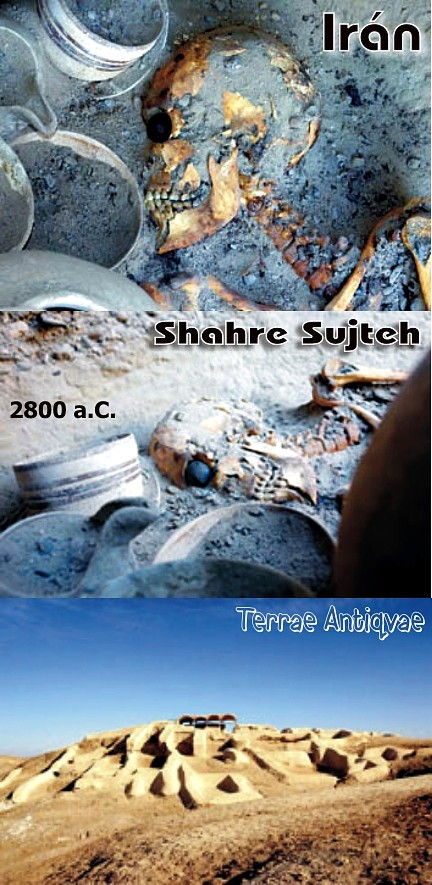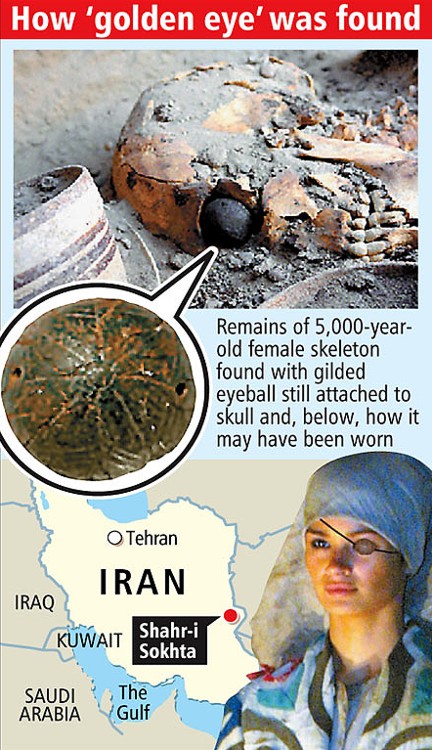Hallado en Irán el ojo artificial más antiguo del mundo
4.800, son nada menos los años que tiene el ojo artificial más antiguo hallado hasta ahora, descubrimiento que se ha hecho en el curso las excavaciones arqueológicas en Shahre Sujte (al este de Irán).
Este ojo pertenecía a una mujer corpulenta de entre 25 y 30 años de edad, que estaba enterrada en la tumba nº 6.708 de esta necrópolis, ha revelado Seyyed Mansur Seyyed Sayyadi, director del grupo arqueológico responsable de las excavaciones.
En alusión a los primeros estudios realizados en el cadáver, que señalan indicios de abscesos bajo la zona de las cejas, Seyyed Sayyadi añadió: Debido al mucho del tiempo transcurrido, con la parte inferior del ojo artificial haciendo contacto con las pestañas, los restos orgánicos de éstas sobre el ojo son aún visibles.
Sobre el material del que está hecho el ojo, indicó que todavía no está claro, lo cual sería determinado en las investigaciones ulteriores, pero al parecer está fabricado con alquitrán natural mezclado con algún tipo de grasa animal.
Según este arqueólogo, para imitar las venas capilares del ojo se han utilizado finísimas hebras de oro de menos de medio milímetro de diámetro. La pupila está en medio y alrededor de ésta hay una cantidad de líneas paralelas que se plasman casi en una forma almendrada, y en los dos extremos hay dos agujeros para sostener el ojo a la cuenca, manifestó.
Seyyed Sayyadi agregó que en esta tumba se han desenterrado también vasijas de barro, cuentas de abalorio, un zurrón y un espejo de bronce.
Los estudios sobre este enterramiento, el esqueleto y este curioso hallazgo siguen su curso.
Shahre Sujteh, que en persa significa Ciudad Quemada, es el nombre de unos extensos yacimientos arqueológicos situados a 55 kms de Zabol, muy cerca de la frontera con Afganistán. En sus más de 150 hectáreas se han realizado hasta la fecha numerosos hallazgos entre las ruinas de esta ciudad preindoeuropea de más de 50 siglos de antigüedad.
Fuente: Teherán, Irán. IRNA. 11 de diciembre de 2006
Enlace: http://www.irna.ir/es/news/view/menu-369/0612111647105648.htm
(2) 3rd Millennium BC Artificial Eyeball Discovered in Burnt City
Historic site of Burnt City, southeast Iran Discovery of an artificial eyeball belonging to 4800 years ago in the historic site of Burnt City has astounded archeologists.
Tehran, 10 December 2006 (CHN Foreign Desk) -- Archeologists in Burnt City announced unprecedented discovery of an artificial eyeball, dated to 4800 years ago, in this historic site.
Announcing this news, director of Burnt City archeology excavation team, Mansour Sajadi, said that this eyeball belongs to a sturdy woman who was between 25 to 30 years of age at the time of death. Skeletal remains of the woman were found in grave number 6705 of Burnt Citys cemetery.
Regarding the material used to make this artificial eyeball, Sajadi said: The material this artificial eyeball is made of has not yet been determined and will be assessed through later testing. However, at first glance it seems natural tar mixed with animal fat has been used in making it.
Initial studies on the eyeball also suggest formation of an abscess in the eyelid due to long-term contact with the eyeball. Moreover, remaining eyelid tissues are still evident on this artificial eyeball.
According to Sajadi, even the most delicate eye capillaries were drawn on this eyeball using golden wires with a thickness measuring less than half a millimeter. There are also some parallel lines around the pupil forming a diamond shape. Two holes are also seen on the sides of this eyeball to hold it in the eye socket.
Initial anthropological studies on the remaining skeleton of the woman to which this artificial eyeball belong revealed that she was a hybrid woman who died 4800 years ago between the ages of 25 to 30.
A number of clay vessels, ornamental beads, a leather sack, and a bronze mirror have also been found in the grave of this woman.
Located 57 kilometers from the city of Zabol in Sistan va Baluchistan province, southeast Iran, Burnt City is one of the most important prehistoric sites of the country which was well developed during the third millennium BC.
Spreading over a 300,000 hectare area, Burnt City was recently recognized as mainland-Irans largest prehistoric site. The city experienced four stages of civilization and was burnt down three times, which is why it was named Burnt City. Discovery of hundreds of historical sites including 166 satellite villages together with large numbers of archeological relics, skeletons, and ancient structures in the archeological site of Burnt City makes it holder of an unparalleled record in the history of archeological activities in Iran.
Fuente: Maryam Tabeshian. foreigndesk@chn.ir / 10 de diciembre de 2006
Enlace: http://www.chnpress.com/news/?section=2&id=6857


2 comentarios
Angel Gomez-Moran -
Glammy -